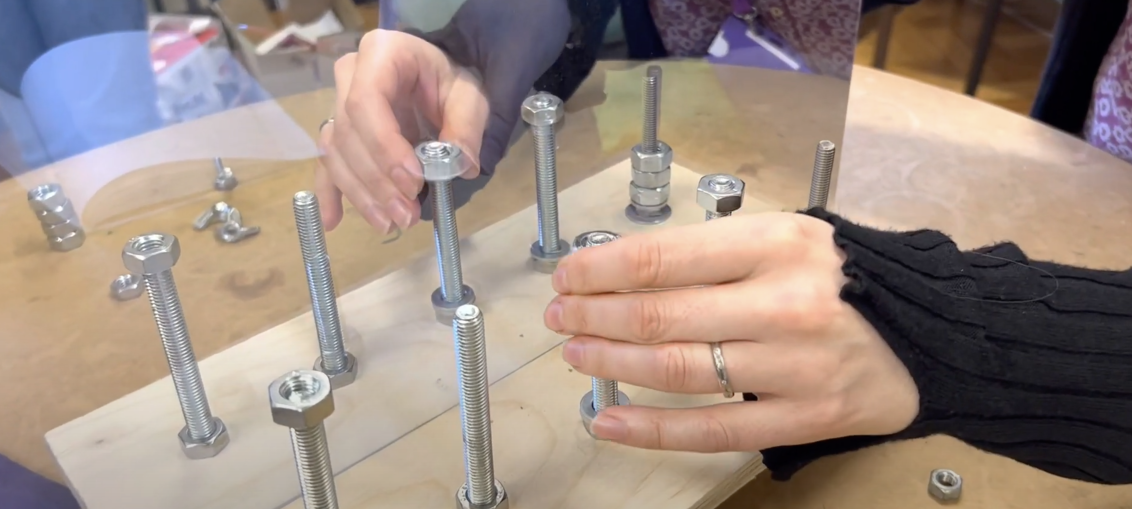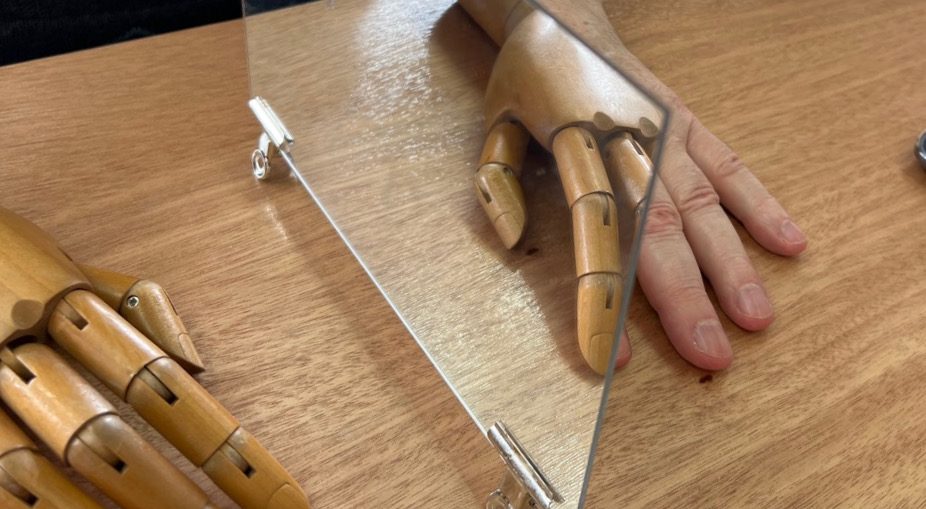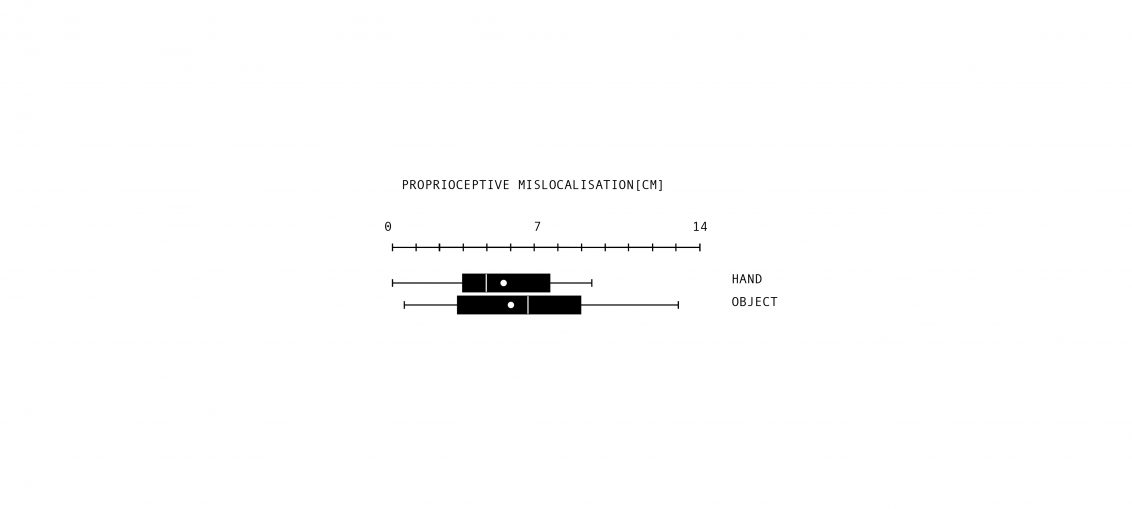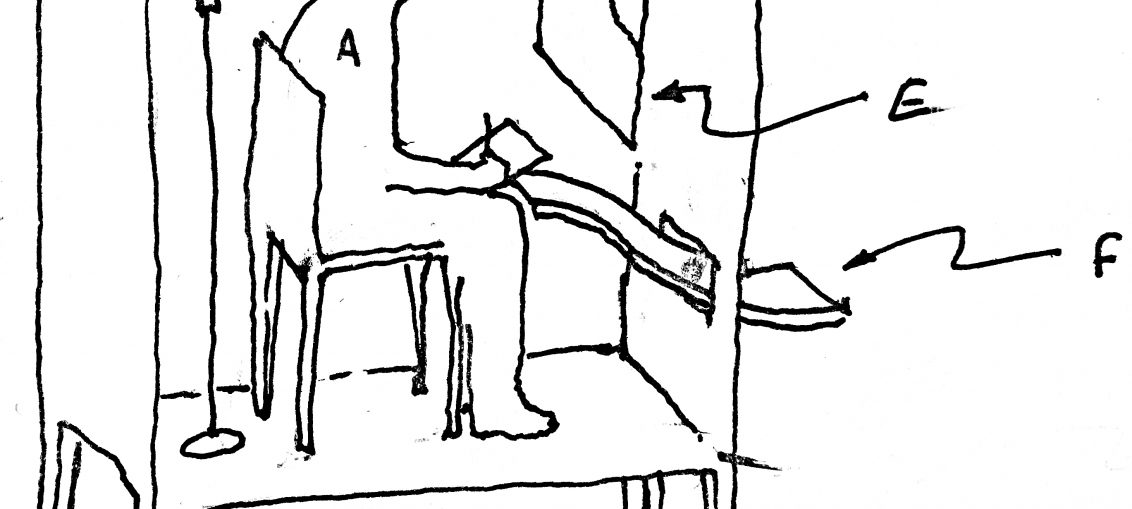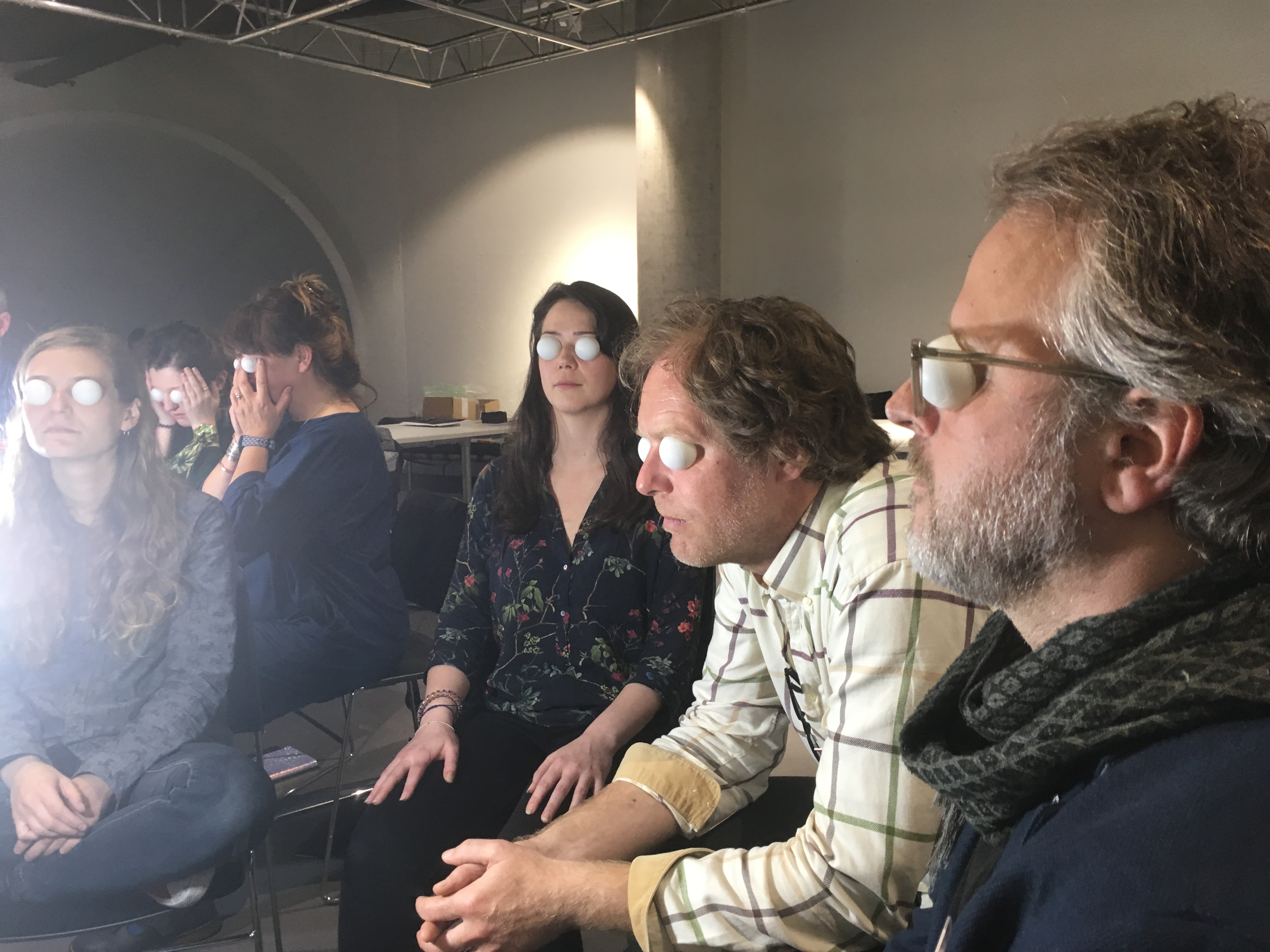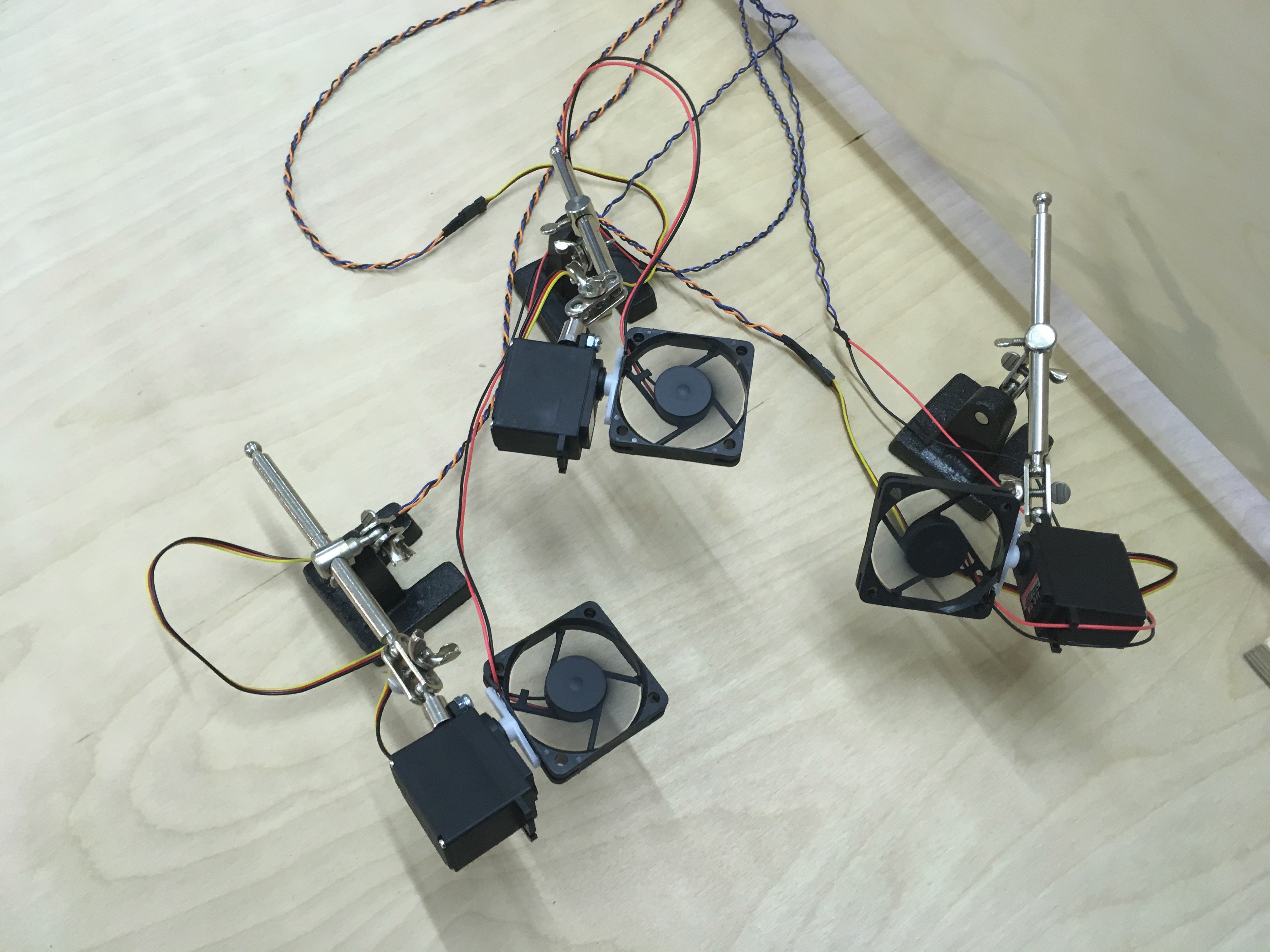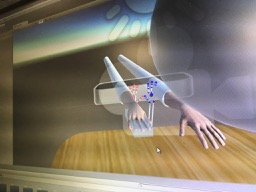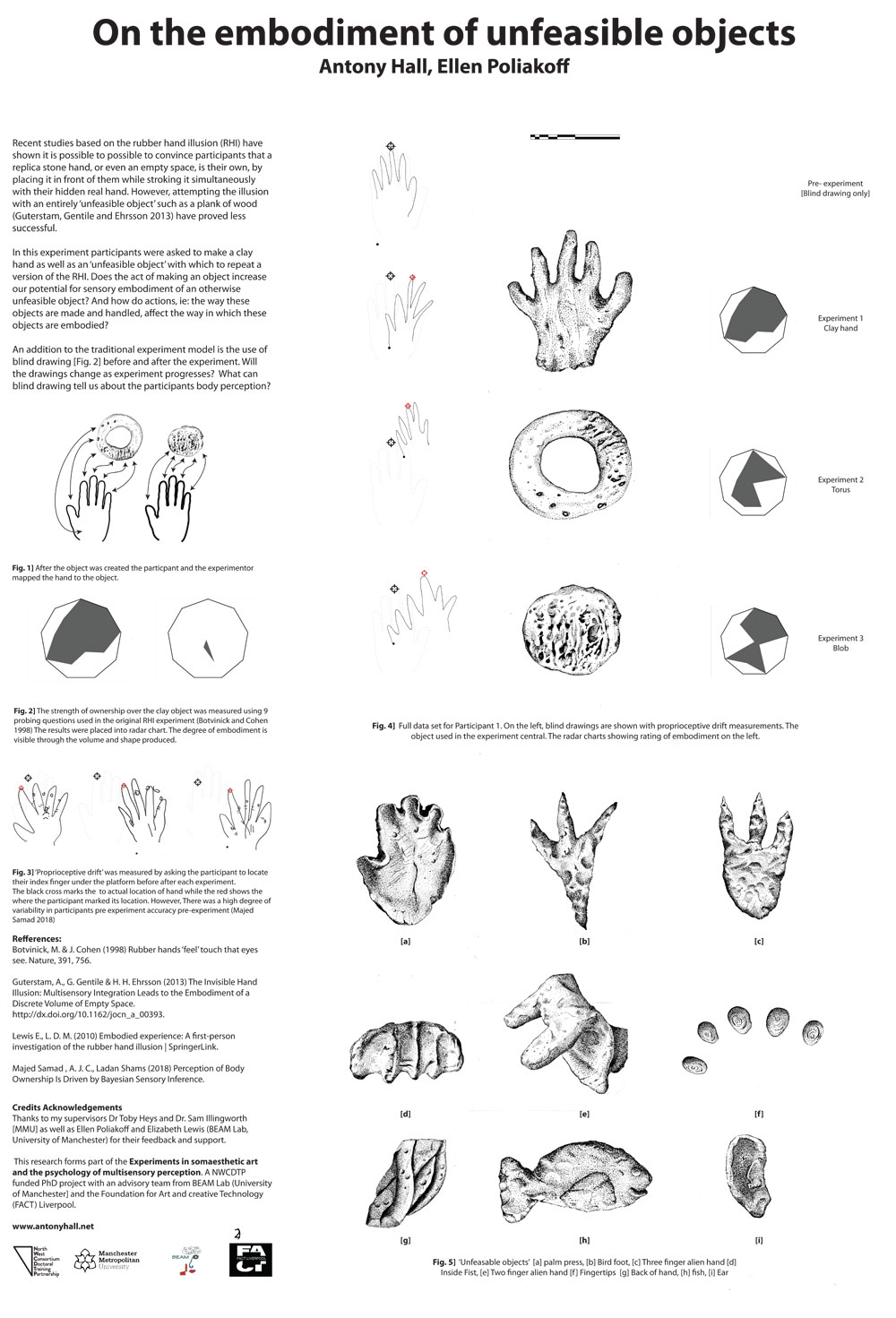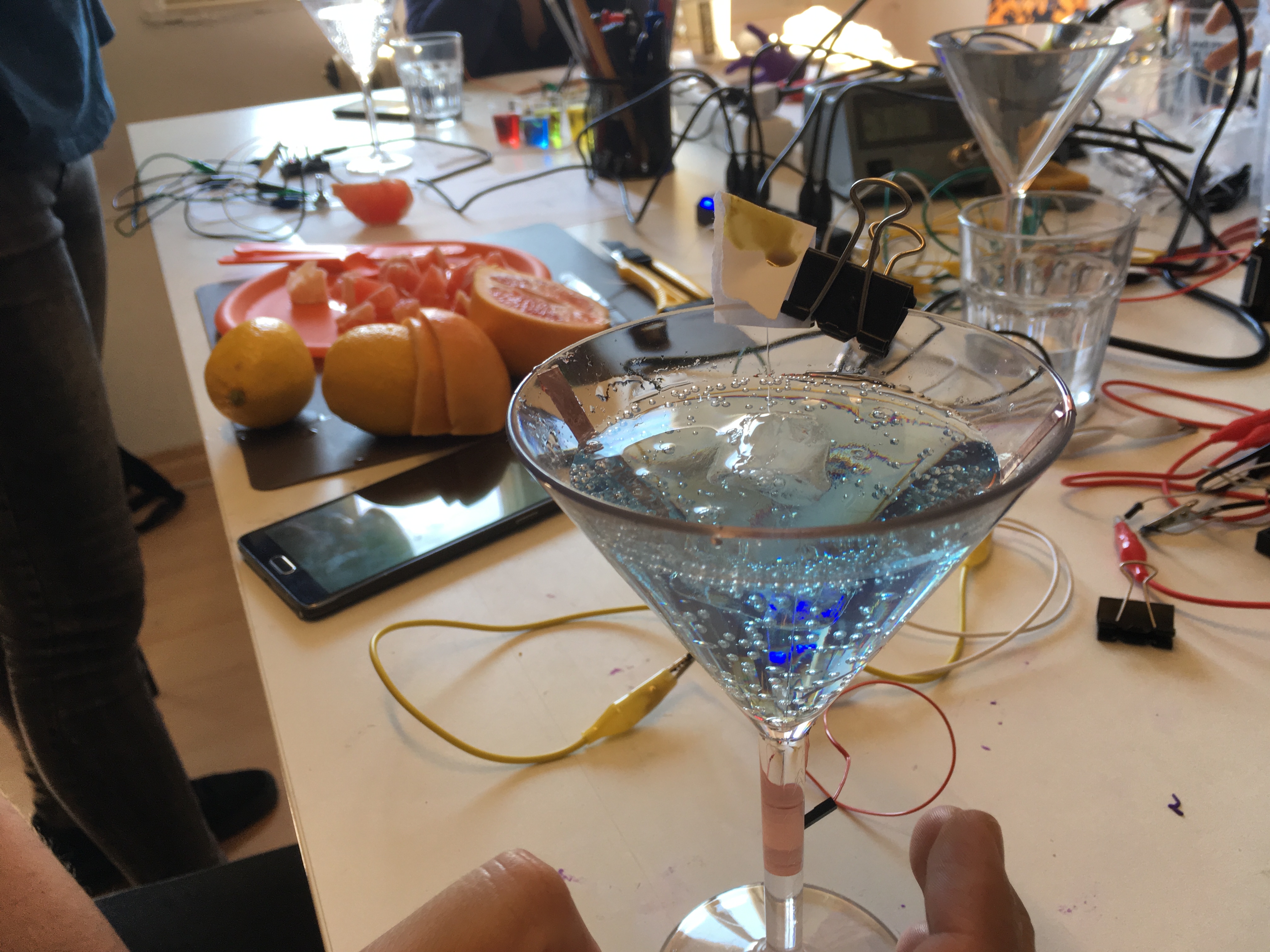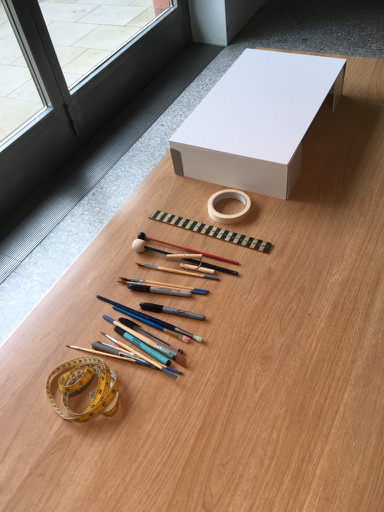This page has some notes and background info on the activities and experiments we are employing for the Experience in Action project with Body Eyes and Movement (BEAM) Lab at the University of Manchester. As part of my PhD research, I ran a number of workshops on perceptual illusions (all inspired by research at BEAM Lab and conversations with Dr. Ellen Poliakoff who also acted as one of my PhD supervisors) . The workshops often used the Rubber Hand illusion (RHI) and its many variations as a starting point. I gave participants instructions and asked them to experiment with different stimuli materials and arrangements and devise new experiments of their own. I found that observing participants experimenting and playing with ideas,
Tag: illusion
Experience in Action
Questionnaire results
Schematic for mirror gaze experiment
Sum Total Of All The Actions 5
Sum Total Of All The Actions 4
Mirror gaze experiment
The mirror gaze experiment requires the participant to sit in a near dark room and to stare at their own reflection for a set amount of time while listing to white noise. After only a short amount of time most people experience powerful illusions of facial distortion, grossly exaggerated features, faces of animals, the face of a lion or Darth Vader for example. These emerge as if from nowhere, disappearing at the slightest movement or eye blink, before manifesting new forms. These flowing cascades of illusory effects can elicit powerful emotional responses. In my own research, the mirror gaze experiment has resulted in significant illusory experiences across the full range of participants. I documented the way in which the illusory experience
6 finger and shrunken Finger illusions
Roger Newport gave a talk on his research at the Body Up conference last week. [See work with the MIRAGE box here Augmented Hands] Speaking to him afterwards, he asked if I had ever experienced the 6 finger Illusion? He reached into his bag and revealed a mirror which he placed on the table. Placing my hand one side of the mirror, he skilfully performed the illusion. Looking into the mirror I watched as each finger was stroked predictably in series, moving from thumb to the little finger, but then continuing to apparently stroke an invisible 6th finger. This worked perfectly for me. What is really interesting is that apparently a very small amount of people have reported seeing this
Autoscope testing at studio
Action Intention Paradox
In this experiment, which is now renamed the 'Alien Hands Experiment' one participant [A] places their hands under a flat-screen monitor. They then see what seems to be their own hands under the screen when in fact these are someone else's hands [B] who is mirroring their actions. The effect can be quite uncanny especially if the appearance of the hand contrast with their own [in scale, age or colour. Participants work together to lead or mirror the movements of what appears to be their own hands under a screen. After a short time, participants experience strange sensations which oscillate between a loss of agency over their own hands and feeling agency over someone else's hands. Action Intention Paradox uses a
Ganzfeld and Mirror Gaze
1-1 experiment sessions in the studio I invited participants to come to my studio to take part in phase 2 of my research. This opens up to using the Ganzfeld and the Strange Face in the Mirror Illusion. Both use white noise connected to a system of biofeedback, using Galvanic skin response signals to subtly modulate the noise. Through this, I have been developing my interview technique and also the working questions that I ask. This has resulted in a new artwork which is taking the form of a questionnaire. Currently, I'm referring to it as the "Hall Anomalous Perception scale" a tongue in cheek reference to the Cardiff scale designed to asses experiences of anomalous perceptions in daily life. A participant
Clay Hand Experiments
Workshops at Manchester City Art Gallery The aim was to deliver an engaging fun activity for all the family which related to the theme of the body and ideas around perception illusion referencing the Leonardo show as well as the Bridget Riley drawings in the Gallery. The workshop was open as a drop-in open to the general public and over the 8 days, we had around 800 people take part in total. The workshop served as an introduction to the idea of ‘perceptual and multisensory illusions’ and was based around my Clay Hand Experiment. I asked participants to work collaboratively to create their own hands and 'unfeasible objects 'with which to perform their own experiments on each other. It provided a
[Re]Mapping perception
Documentation from the [Re]Mapping perception workshop at LJMU 2 May 2019 Here is the original invitation... A workshop for artists/researchers engaging in a wide range of practice-based and artistic research methodologies. It aims to explore interdisciplinary methods through a series of provocations in embodied multisensory experience, designed to enhance our perception and self-awareness. The workshop provides an open space for participants from different fields to meet, communicate findings, share paradigms, and explore the value of sensory perception and awareness in our research. It also offers an opportunity to meet Madeline Schwartzman and gain insight into the works discussed in her new book See Yourself X: Human Futures Expanded. Her public lecture follows the workshop [ Places can be booked here https://www.eventbrite.com/o/antony-hall-19862154602 ] [Re]Action Lab is an
Rubber/clay Hand experiment UoM
I supported some seminars on the Rubber Hand Experiment with undergraduate psychology students, presenting some of my research ideas [unfeasable objects and the Clay Hand Experiment] The idea was they experience the experiment for themselves before designing their own.
Augmented hands
‘Augmented hand series’ by Golan Levin, Chris Sugrue, and Kyle McDonald, 2013-2015) ‘MIRAGE Illusion Box’ (Roger Newport, 2008) These are two very similar projects which both transform the image of a hand in real time using Augmented Virtuality (AV, the digital manipulation of real-world objects). Both take the form of a black box, into which the hand is placed. When inside the participant can see their hand as if looking through a window into the box. Inside the box, a system of mirrors and motion tracking is used. An augmented or distorted digital image of the hand is relayed to a screen on the top of the box. Despite the technical similarities, both works stem from entirely different motivations. The ‘MIRAGE Illusion Box’ (Newport, 2018)
Be Another Lab
This International group interdisciplinary group adopt mechanisms employed in the cognitive sciences, such as the work of Mel Slater, and the arts. Their project ‘The Machine to Be Another’ allows anyone to experience a perspective from the body of an-other. The group speak of ‘expanding subjective experience’ and ‘understanding the relationship between identity and empathy from an embodied perspective’ (http://beanotherlab.org/) Using HMDs and live video, they have developed a number of critical applications. Investigating a wide range of issues including gender and disability. The group study the impact this work can have on people’s lives, employing methods of action research and co-creation. Be Another Lab embraces an open source approach. Sharing and developing their project through workshops, making the tools and
Labyrinth Psychotica
Labyrinth Psychotica is an artistic research project that aims to simulate the experience of psychosis. It uses multisensory [tactile and sonic] elements in combination with the maze environment, to create a fully immersive experience. The maze mechanism also serves as a metaphor for attempting to get inside the mind of another. The investigation aimed to not only portray an experience of psychosis but one that was ‘artistic’. It further asks if such an endeavour could prove ‘useful’. Though I can only speak from my experience of the work [1], it did seem effective in conveying elements of this experience, such as; loss of personal boundaries, and blurred borders between the body and space. Another element which resonates with Action Lab is the
Tactile Anchoring Device prototype 2
The first film of the Tactile Anchoring Device in progress, showing the use of brushes and fans to generate the illusion of an invisible hand... https://youtu.be/vHaB6HBbQrs The system is based on an Arduino controls two sets of identical stimuli which move in synchronisation with each other [ servo motor, articulating solenoids, fans, lamps etc] Once the participant is experiencing the illusion, the operator or autonomous systems can trigger a ‘shock’ or threat stimuli. This is currently in the form of a solenoid which releases a heaved plum line weight which drops into the empty space. See the project page here. http://antonyhall.net/blogtactile-anchoring-device/
Meeting With Sally Linkenauger
Notes from a meeting With Sally Linkenauger Lancaster University Psychology Dept. After discovering Sally's research at the BRnet conference I wanted to experience her experiments, so I asked if I could visit her lab. The VR lab looks like a normal office space, PCs scattered around the outside, and loads of VR tech hanging around. On closer inspection, a network of cameras is installed around the space to enable complex motion capture and augmented reality experiments to be undertaken. There is a treadmill in the corner. In the experiment I tried, a leap motion sensor captures the movements of your real hand, allowing you to articulate a virtual hand. The experiment requires some time to become used to the VR environment. At first,
Lenticular goggles
Speaking with an artist while making plans for a future Action Lab, I came up with the idea of making these lenticular glasses [Above], which use a lenticular lens [textured with lines or ridges] which have the effect of dividing the visual field into lines. In an urban or interior space, vertical and horizontal lines are common. These become enhance or reduced depending on the orientation of the lens. Using the lens in a vertical alignment, steps become invisible, but when the lens is rotated they become enhanced. Using a combination of both things get even stranger. Point light sources create strong bright lines. I have yet these in a natural environment.
The Multi-faceted body
A few notes from the BRnet Conference the Multi-faceted body. June 2018, Heriot-Watt University, Edinburgh, UK I felt strangely at home among so many research projects that use the hand as a model for the wider issues of body representation and ownership. Keynote speaker Mel Slater's talked about his playful and engaging research. Slater’s work centres around the idea of using immersive virtual reality as a medium to transform the self, not just the reality of a space. His research projects include self-help therapy. The project Personified Self Interaction (Osimo et al., 2015) allowed ‘you’ [embodied within an avatar of Freud] are able to talk to ‘yourself’ [an automated replay of you, embodied within an avatar of yourself] and vice-versa. This enables the
Phantom Presence
This experiment induces the sensation of a phantom presence in the room. The participant blindfolded is asked to use a stylus to prod an empty space in front of them. Using a tactile feedback system and a robot arm, the participant feels as if they are prodding themselves in the back. As the experiment progresses the system adds a delay to this prodding. At this stage, the participants become freaked out believing that someone else if prodding them... https://youtu.be/GnusbO8QjbE Link to the paper... Neurological and Robot-Controlled Induction of an Apparition https://www.cell.com/current-biology/abstract/S0960-9822(14)01212-3
Fieldwork / Night walk
I teamed up with artist Annie Carpenter to pull together a small group of artists and friends for a night of ‘fieldwork’. We organised an overnighter to do some experiments and have discussions together in the relaxed atmosphere of Middlewood Trust study centre; an off-grid permaculture farm. I had worked here before with [Annie and Sam Illingworth] doing some workshops with their students on a previous 'field research' style project. The concept captured my interest. We wanted to create a situation where we could work as well as have time and space to chat about ideas with others. My equipment consisted of my laptop, Arduino, [with a relay shield for experiments] and some electronics, GoPro, 360-degree camera. Also a heavy rechargeable
Tactile Anchoring Device Prototype 1
Here is my prototype device intended to help autonomously generate the 'invisible hand illusion'. For this experiment, I created a series of brushes which rotate at different speeds stroking empty space. The idea was that the participant watches this device, while the brushing motion is replicated one their real hand hidden nearby. This is building towards a piece of work called 'On the embodiment of a discrete Volume of Empty Space' [ See http://antonyhall.net/blogtactile-anchoring-device/ ] https://www.youtube.com/watch?v=DI-f6KgRD2w&w=700&h=400
“On the embodiment of a discrete volume of empty space”
As I mentioned before [Illusions of Invisible, alien hands, 3 arms, and shrinking bodies…] The Invisible Hand Illusion is a version of the Rubber hand illusion which uses no fake rubber hand at all. Instead, the participant focuses on an empty space in place of their hand. Sometimes a handless stump, and as a control, a wooden plank. they found that participants could embody a ‘Discrete Volume of Empty Space’. This interests me as it fits with a number of works which challenge the physicality of the art object, instead, I have presented amorphous forms of bubbling materials or even a plinth which automatically concealed the object. The idea of making an automated system to generate the illusion of an invisible hand seems the next step for my research.
Poster – BRnet Conference 2018
Electronic Taste Perception Workshop – Radiona
[Here is some documentation from one of the activities for the 're-mapping the senses workshop earlier this year...] Our sense of taste is directly affected by the colour and smell of the food. Experiments prove that the colour of a drink affects our perception of its sweetness for example. Altering the sound of the food, say adjusting the high-end frequencies while eating crisps can also affect our perception of the crunchiness of those crisps [see the paper here. Playing with these assumptions and expectations can create heightened food experiences. There have been a number of studies that suggest it is possible to simulate Sweetness, bitterness, sourness. Specifically, we test these settings as claimed by the Vocktail project [see below] to simulate the following sensations... Sour: magnitude of current: 180
Clay Hand Experiment – Whitworth Art Gallery
This was the first of the public workshops performed specifically for my research. My experiments so far have taken place as 1-1 sessions in artists studios or at the university. In a more open drop-in format, the participants were invited to experiment on themselves. Opening up the environment to one of play rather than pure participation. Breaking the experimenter/participant loop, creating a flexible relationship between myself and the participants. This was more in keeping with the idea of a phenomenological investigation allowing the experience to ‘unfold’. This had a dual effect of actively involving and empowering the participants while being able to observe the process from the outside. This meant notes and make recordings could be taken more effectively. Further reading:Read more
Proprioceptive drift visualisation
[wpvideo VartTqKO ] My experiments show a strong ‘drift’ in the perceived location of the hand before and after the experiment. This is known as proprioceptive drift. I asked people to locate the position of their index finger under a platform before and after embodying a clay object. And also draw their hand without looking before and afterwards. This animation shows these superimposed, illustrating the drift away from the real location of the hand.
Fish-brain-machine / Radiona workshop
After constructing the Fish-brain-machine PCB circuits we spent some time experimenting and describing the hallucinogenic visuals created by the stroboscopic light. The ping pong balls over the eyes diffuse the LED light, making for a more intense effect - and enabling use with eyes open. Here they describe some of the effects including seeing colours and 'a strange experience' of seeing with only one eye - I get this exact same feeling when using it. It is also hard to know if your eyes are open or closed. [See also Re-mapping the senses workshop ] https://www.youtube.com/watch?v=Lwne5xICLkI
